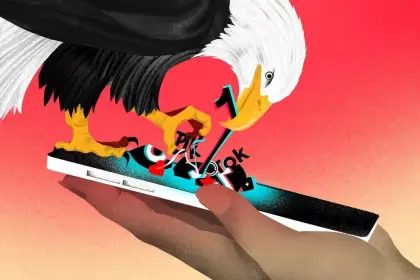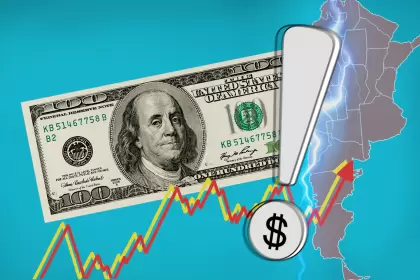Por Gonzalo Martínez Mosquera
La semana pasada, Christine Lagarde, directora del Banco Central Europeo, comentó que al menos 80 bancos centrales del mundo están considerando lanzar una CBDC (dinero digital del banco central, por sus siglas en inglés).
Como saben los lectores de esta columna, una CBDC implicará que las empresas, las familias, los gobiernos municipales y provinciales, etcétera, podrán acceder a cuentas bancarias en el banco central sin depender de intermediarios como los bancos para ello.
Toneladas de papers se están escribiendo al respecto mencionando las oportunidades y amenazas que tal lanzamiento implicaría. Uno de los riesgos más mencionados es el de una corrida bancaria de depósitos bancarios hacia CBDC que quitara financiación a los bancos comerciales y que, de esa forma, restringiera su capacidad de dar préstamos.
¿Tiene sentido ese razonamiento? ¿Estamos ante un peligro inminente que pusiera en riesgo todo el sistema financiero?
Voy a argumentar que la respuesta a esas preguntas es un rotundo “no” y que, al contrario, esa corrida generaría un sistema financiero más robusto con un formato “natural” que hasta ahora no era posible por restricciones tecnológicas.
¿Que es un depósito bancario?
Un depósito bancario es el registro de una deuda que el banco tiene con su depositante.
¿Qué ocurriría con esos depósitos bancarios si ese banco quebrara? Me refiero aquí a los depósitos bancarios en moneda nacional emitidos por bancos con licencia bancaria emitida por el banco central.
Simple, el banco central los respaldaría y el depositante no perdería su depósito.
En Estados Unidos, por ejemplo, los depósitos hasta US$ 250.000 están asegurados y, como me contestó un exfuncionario de la autoridad monetaria argentina cuando le consulté al respecto, en los hechos el resto de los depósitos también están respaldados ya que la Fed saldría a rescatarlos en caso de turbulencias financieras.
Pero si los depósitos están asegurados por el banco central, ¿no implica eso que, en el fondo, son también una deuda de la autoridad monetaria y que los bancos comerciales en realidad actúan como sus agentes, al menos en lo que respecta a los depósitos asegurados?
Es precisamente esa la razón por la cual los bancos necesitan una licencia para operar y son regulados por la autoridad monetaria.
Por otra parte, esos bancos no sólo actúan como soporte de la plataforma de pagos sino que además crean depósitos bancarios (dinero) cuando prestan. Sí, como aclaró el famoso paper del Banco Central de Inglaterra de 2014, los bancos no prestan sus depósitos sino que crean los depósitos cuando prestan.
La operación contable es así: en el activo colocan la promesa de devolver el dinero que firma el prestatario y en su pasivo crean un depósito bancario a favor del mismo.
Pero entonces, si los bancos no prestan los depósitos, ¿de dónde obtienen el “fondeo” para esos préstamos?
Simple, del banco central cuando, a través de la licencia que mencionamos antes, les otorga la potestad de crear depósitos bancarios que pueden ser utilizados, entre otras cosas, para pagar impuestos. Los bancos crean esos depósitos marcando números en una computadora. De ahí surge el dinero, de los dedos del empleado del banco.
¿Qué ocurre entonces si el depositante decidiera “llevarse” el depósito a otro banco?
Así como los bancos tienen en su activo las promesas de pago de los prestatarios que respaldan los depósitos bancarios, también tienen en sus activos reservas en el banco central. Estas reservas son deudas de la autoridad monetaria con los bancos.
Cada vez que un depositante mueve su depósito a otra entidad, el banco pierde tanto ese pasivo (depósito) como el activo que tiene contra el banco central (reserva). Ambos pasan a formar parte del balance del banco que recibió el depósito
En caso de que el banco original no tuviera suficientes reservas para afrontar las salidas de sus depósitos lo que ocurre es, como suele recordar Warren Mosler (quien desarrolló la Teoría Monetaria Moderna), que el banco central otorga un giro en descubierto automático.
Nótese que el banco central suministra las reservas de manera automática y, si no lo hiciera, el sistema de pagos se cortaría cada vez que un banco no alcanzara a tener las reservas suficientes para respaldar sus salidas de depósitos (por movimientos a otras entidades o por el pago de impuestos).
De todas formas, el giro en descubierto tiene un costo y para evitarlo los bancos pueden pedir prestadas reservas a otros bancos en el mercado interbancario. Es ese mercado aquel donde se define la famosa tasa a la cual suele apuntar la autoridad monetaria cuando define su target de política monetaria.
Nótese que esa definición implica que el banco central pierde su independencia respecto al otorgamiento del fondeo necesario a los bancos. Si en aquel mercado hubiese mayor demanda de reservas que la oferta disponible, eso generaría una suba de la tasa que “obligaría” a la autoridad monetaria a intervenir suministrando las reservas necesarias.
Por lo tanto, podemos concluir que los bancos siempre conseguirán fondeo a la tasa de política (o a la tasa del giro en descubierto mencionado) y que el costo de ese financiamiento será el que surja de promediar el fondeo “gratuito” por la recepción de depósitos de otros bancos y aquel obtenido en este mercado.
Ese costo dependerá entonces de la capacidad que tenga el banco para atraer depositantes, por ejemplo, generando buenas asociaciones con compañías aéreas para otorgar programas de millas a sus potenciales clientes.
Cabe preguntarse entonces si tiene sentido que el costo de fondeo, que como vimos, en última instancia es otorgado por el banco bentral, dependa de las políticas de marketing y atención a clientes que otorgan esos bancos.
En mi opinión, no pareciera esa la mejor forma de distribuir esa capacidad para crear dinero en la economía. Es, de hecho, una reminiscencia de la forma en la cual se desarrolló el sistema que implicaba la necesidad o conveniencia de que fueran los mismos bancos que creaban los depósitos cuando prestaban aquellos que fueran el soporte para la plataforma de pagos.
¿Cómo funcionaría el sistema en el futuro?
Por un lado tendremos bancos que emitirán CBDC cuando presten y, en vez de tener en sus pasivos los depósitos bancarios, tendrán una deuda con el banco central que pagaría la tasa de interés de política monetaria.
Por otro lado existirán los proveedores de sistemas de pagos oficiales (y regulados) que ayudarán a conectar a los “depositantes” con la autoridad monetaria y que serán la plataforma de pagos donde circule la CBDC.
Beneficios del nuevo sistema
-Todos los bancos tendrían acceso a la misma tasa de financiación para el otorgamiento de préstamos, lo que implicaría una mejor distribución de los movimientos en la tasa de política monetaria (en caso de que se considere útil esta herramienta).
-Esa tasa de fondeo no dependería de la capacidad de atraer clientes nuevos y, por lo tanto, la rentabilidad bancaria estaría en función de su capacidad para dar buenos préstamos.
-Los esfuerzos por atraer nuevos clientes como forma de bajar el costo de fondeo se volverían superfluos lo cual liberaría recursos reales en la economía para su utilización en tareas más útiles.
-El depositante tendría una herramienta muy clara para distinguir entre dinero “real” (respaldado por el banco bentral) y aquellas promesas de pagos hechas por entidades no bancarias también conocidas como “shadow banking” (“bancos en las sombras”, en inglés). Un ejemplo de estos son las stablecoins que surgieron en los últimos años en el mundo cripto.
-La plataforma de pagos estaría soportada por entidades especializadas que podrían dar un mejor servicio que aquel que dan los bancos hoy en día.
-Dado que todas ellas manejarían el mismo ente digital (la CBDC), la interoperabilidad, que es fundamental, sería mucho más simple de obtener.
-Existen otros beneficios de las CBDC que suelen ser mencionados en los papers, como por ejemplo la posibilidad de tener un ente digital programable, pero que van más allá del objetivo de este artículo.
Conclusión
Las CBDC son un fenómeno que crece sin pausa.
Uno de los riesgos más mencionados es la posible desfinanciación del sistema bancario por una corrida de depósitos hacia ellas.
Un correcto entendimiento del sistema monetario y del funcionamiento de los bancos que emiten depósitos bancarios garantizados por la autoridad monetaria nos permite observar que esa “corrida” es algo deseable y conveniente.
No solo mejoraría la distribución de fondeo del banco bentral para préstamos sino que además liberaría recursos del sector bancario y promovería la innovación en el sistema de pagos.
En el fondo, la pregunta que hay que responder no es por qué deberíamos emitir una CBDC sino, más bien, ¿por qué no deberíamos emitirla?
Después de todo, la razón por la que quienes otorgan préstamos son los mismos que proveen la plataforma para el sistema de pagos es una reminiscencia de tiempos que la tecnología ha dejado atrás y que, por lo tanto, nos obliga a replantearnos si su diseño es el más eficiente para lograr el bien común.
***
CBDC: the biggest bank run in history is coming and it would be a great idea
Last week Christine Lagarde, director of the European Central Bank,commented that at least 80 central banks around the world are considering launching a CBDC (Central Bank Digital Currency).
As readers of this column know, a CBDC will involve businesses, families, municipal and provincial governments, etc. They will be able to access accounts at the central bank without depending on intermediaries such as banks for this.
Tons of papers are being written about it mentioning the opportunities and threats that such a launch would imply. One of the most mentioned risks is that of a bank run on bank deposits to CBDCs that would remove financing from commercial banks and thus restrict their ability to make loans.
Does that reasoning make sense? Are we facing an imminent danger that would put the entire financial system at risk?
I will argue that the answer to these questions is a resounding "no" and that, on the contrary, this run would generate a more robust financial system with a "natural" format that until now was not possible due to technological restrictions.
What is a bank deposit?
A bank deposit is the record of a debt that the bank has with its depositor.
What would happen to those bank deposits if that bank failed? (I am referring here to bank deposits in national currency issued by banks with a banking charter issued by the central bank).
Simple, the Central bank would back them and the depositor would not lose his money.
In the United States, for example, deposits up to $ 250,000 are insured and, as a former official of the Argentine monetary authority answered me when I asked him about it, in fact the rest of the deposits are also backed since the Fed would come out to rescue them in the event of financial turmoil.
But if the deposits are insured by the Central bank, does that not imply that they are also a debt of the monetary authority and that the commercial banks actually act as their agents (at least as far as deposits are concerned).
This is precisely the reason why banks need a license to operate and are regulated by the monetary authority.
On the other hand, these banks not only act as a support for the payment platform but also create bank deposits (money) when they lend. Yes, as the famous 2014 Bank of England paper showed, banks do not lend their deposits but create deposits when they lend.
The accounting operation is like this: in the Assets side they place the promise to return the money signed by the borrower and in the Liabilities side they create a bank deposit in favor of the borrower.
But then, if the banks don't lend the deposits, where do they get the “funding” for those loans?
Simple, from the central bank, when through the charter that we mentioned before grants them the power to create bank deposits that can be used, among other things, to pay taxes. Banks create these deposits by dialing numbers on a computer. That's where the money comes from, from the fingers of the bank clerk.
What happens then if the depositor decides to "take" the deposit to another bank?
Just as banks have in their assets the payment promises of the borrowers that back bank deposits, they also have reserves which are currency assets owed by the Central bank. These reserves are debts of the monetary authority with the banks.
Every time a depositor moves his deposit to another entity, the bank loses both that liability (deposit) and the asset it has against the central bank (reserve). Both become part of the balance sheet of the bank that received the deposit.
If the original bank did not have enough reserves to face the outflow of its deposits, what happens is, as Mosler (who developed the Modern Monetary Theory) often recalls, that the Central bank grants an automatic overdraft.
Note that the Central bank supplies the reserves automatically and if it did not do so, the payment system would fail every time a bank did not have sufficient reserves to support its deposit outflows (due to movements to other entities or due to the tax payment).
However, there is a cost to those overdrafts and to avoid it, banks can borrow reserves from other banks in the interbank market. It is that market that defines the famous rate at which the monetary authority usually points when it defines its target policy.
Note that this definition implies that the Central bank loses its independence with respect to granting the necessary funding to the banks. If there was a greater demand for reserves in that market than the available supply, this would generate a rise in the rate that would “force” the monetary authority to intervene by supplying the necessary reserves.
Therefore, we can conclude that banks will always get funding at the policy rate (or at the rate of the aforementioned overdraft) and that the cost of this financing will be the one that arises from averaging the “free” funding for receiving deposits from other banks and that obtained in the interbank market.
That cost will then depend ultimately on the bank's ability to attract depositors, for example, by generating good partnerships with airlines to grant mileage programs to potential customers which becomes the de facto cost of that “free borrowing” mentioned before.
It is worth asking then if it makes sense that the cost of funding, which as we have seen, is ultimately granted by the Central bank, depends on the marketing and customer service policies granted by those banks.
In my opinion, that doesn't seem like the best way to distribute this ability to create money in the economy.
It is, in fact, reminiscent of the way in which the system was developed, which implied the need or convenience that they were the same banks that created the deposits when they lent those that were the support for the payment platform.
How should the system work in the future?
On the one hand, we will have banks that will issue CBDC when they lend and, instead of having bank deposits in their liabilities, they will have a debt with the Central bank that would pay the monetary policy interest rate.
On the other hand, there will be providers of official (and regulated) payment systems that will help connect “depositors” with the monetary authority and that will be the payment platform where the CBDC circulates.
Benefits of the new system
-All banks would have access to the same financing rate for granting loans, which would imply a better distribution of movements in the monetary policy rate (if this tool is considered useful).
That funding rate would not depend on the ability to attract new clients and, therefore, bank profitability would be a function of its ability to give good loans and not of their marketing actions.
-Efforts to attract new clients as a way to lower the cost of funding would become superfluous, which would free up real resources in the economy towards more useful tasks.
-The depositor would have a very clear tool to distinguish between “real” money (backed by the Central bank) and those promises of payments made by non-bank entities also known as “shadow banking”. An example of these are the stablecoins that emerged in recent years in the crypto world.
-The payment platform would be supported by specialized entities that could provide a better service than that provided by banks today promoting better innovation.
-Since all of them would handle the same digital entity (the CBDC), interoperability, which is essential, would be much simpler to obtain.
-There are other benefits of CBDC that are usually mentioned in those papers, such as the possibility of having a programmable digital entity, but those go beyond the objective of this article.
Conclusion
CBDC are a growing phenomenon.
One of the most mentioned risks is the possible underfunding of the banking system due to a run on deposits towards them.
A correct understanding of the monetary system and the operation of banks that issue bank deposits guaranteed by the monetary authority allows us to observe that this "run" is something desirable and convenient.
It would not only improve the distribution of funding from the Central bank for loans, but it would also free up resources from the banking sector and promote innovation in the payment system.
Ultimately, the question that needs to be answered is not why should we issue a CBDC but rather why we shouldn't.
After all, the reason why those who make loans are the same ones who provide the platform for the payment system is reminiscent of times that technology has left behind and therefore forces us to rethink whether their design should remain the same.








